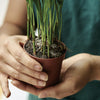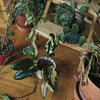6 tips to manage the winter season without losing your bouquet - literally

With the arrival of winter, the living conditions in apartments and houses will change, and this will be felt not only by us, but also by our houseplants. The amount of daylight will decrease dramatically, the heating will reduce the humidity, and if you have plants near the window that don't seal well enough, you're already in for trouble. Dry and twisted leaves or their edges or even falling leaves and rotting stems... Sound like a horror? And what about daily plucking flowers from a crowded windowsill when you want to air out the room for a while! If spring is just around the corner and you're still worried about which of your next maids will be fighting for their lives, we have some tips for you in the following article. You will learn what is actually needed to keep indoor plants happy in winter and what to avoid.
1. Lighting conditions
We have to move plants that like plenty of light as close as possible to the windows during the winter, or provide them with special lighting, the so-called grow light . It certainly doesn't hurt to wash the windows from dust and dirt so that nothing obstructs the passage of light, and also to wipe or shower the leaves of the plants once in a while so that they can receive the light without problems. It also benefits the plants, and not only in winter, when we regularly rotate them together with their flower pot. 10° - 30° is enough for them to get used to the new position and not be pulled unevenly behind the light. More details about lighting conditions here .
2. Draft
Plants on windowsills are only part of the success. If you have older windows that don't seal well, your plants could still be exposed to drafts or cold temperatures. Think about it and try to seal the windows better. Many types of houseplants are native to tropical regions and therefore cannot be prepared for the cold season. This also applies to ventilation – it is best to move the curtains away from the windows to a safe distance before letting the cold fresh air in. Don't forget this when buying new plants and protect them sufficiently during transport !
On the contrary, it is desirable to maintain a moderate movement of air around the plants. You can solve this by purchasing a fan, for example.
3. Air humidity
Dry indoor air is not good for us or our plants. A great accessory for both parties is an air humidifier, thanks to which we can maintain humidity ideally in the range of 45-60% . It will also help the plants if we group them in their places and put expanded clay/stones with water in their trays (ordinary glasses with water will also suffice), from which the water will slowly evaporate, thus increasing the humidity in the immediate vicinity of the plants . You can also try watering the plants, but watch out for leaf rot.
4. Topping
Due to the fact that many plants are dormant in winter and do not grow, they do not need as much water . Also because the days are shorter, the plant doesn't even have time to use the excess water, its substrate will still be moist and it will start to rot . So we have to reduce the frequency of watering, or just keep an eye on plants that are planted in a terracotta pot (thanks to it, the root ball dries out more and the plant will need a little more water than, for example, in ceramic or plastic). Don't forget to water with standing water at room temperature , as you do all year round!
From late autumn to early spring, there will be no need to fertilize the plants, you can only lightly fertilize those that are still growing (e.g. some types of peperomia, pothos (climbing plants), philodendrons). It could even harm the plant, as an excess of nutrients can burn the roots.
5. Pests
Unfortunately, pests thrive more than usual in winter. It is advisable to inspect the houseplants more often , don't be afraid to take a flashlight to help (yes, even during the day) and check the leaves and stems of each plant in detail. If you find signs of pest infestation, treat the plant (according to the type of pest) and quarantine it away from other plants to prevent the spread of the infection. If you are bothered by, for example, flying flies from flower pots, read about getting rid of them here .
6. Special types of plants
Some types of indoor plants have special requirements during the winter. For example, cacti and succulents need to be wintered in a dry substrate without any watering and at temperatures around 10°C. Some palms also require a cooler environment. It always depends on the specific species, so you need to find out at least basic information about the plant in question.
Tip:
During the winter , it is not advisable to transplant the plants (unless they are in a bad or overwatered substrate) or propagate them using cuttings (rooting takes longer and the mother plant can be unnecessarily exhausted by many cuttings in the winter). It is better to wait until spring with these activities.
And especially! Remember that every winter will end one day and the plants will be full of strength again in the spring. Sometimes, unfortunately, despite all the care, some leaves fall off, because the plant cannot feed them all in the winter. Or, God forbid, the whole plant won't survive... But that's another reason to buy another one, because you learn from mistakes and the more maids, the more experience, right?
Roommates everyone!
Elizabeth Lacinová
-
Posted in
Zajímavosti a tipy




